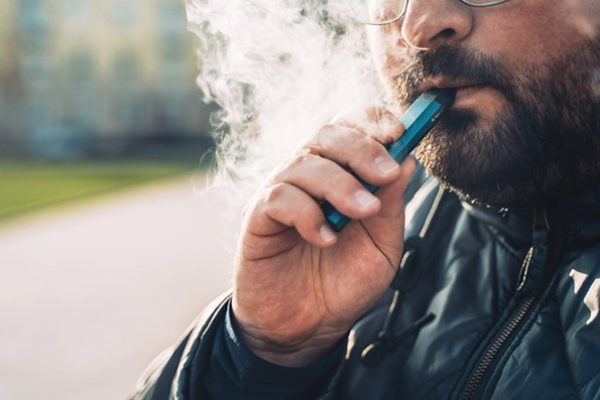The Centers for Disease Control and Prevention (CDC) is no longer tracking cases of lung injury tied to vaping, which peaked in mid-September 2019 with upwards of 200 hospital admissions reported per day. On Feb. 9, the last date for which data is available, the CDC reported four vaping-related hospital admissions.
That’s an additive rarely found in vaping products purchased at dispensaries in states where marijuana is legal. Instead, it’s more frequently a component in illicit, black-market products — and is now explicitly banned by Colorado’s Marijuana Enforcement Division.
Now, a new study published in JAMA Network Open, an American Medical Association journal, sheds light on a potential link between marijuana legalization and cases of vaping lung injury.
Researchers affiliated with Indiana University found that cases of lung injury “were concentrated in states where consumers do not have legal access to recreational marijuana dispensaries.”
On average, the seven states where recreational marijuana is legal had 1.7 cases of lung injury per 1 million people. Colorado, for example, had between 0.17 and 1.6 cases per million, according to CDC data and U.S. Census Bureau population estimates.
In Texas — which prohibits marijuana use completely — between 6.9 and 8.6 per 1 million people contracted the illness. “The reason for this association is not yet clear,” the researchers wrote. “It is possible that in recreational states, people tend to purchase marijuana products at legal dispensaries, which may be less likely to sell the contaminated products that are thought to cause EVALI [E-cigarette or Vaping-Associated Lung Injury, the medical name for the illness].”
Interestingly, the researchers found no association between average rate of e-cigarette use and the number of EVALI cases.
“Unfortunately, natural product mixtures come with many problems and these problems increase with the number and concentration of different molecules in the mixture,” Williamson continues. “A pharmaceutical natural product chemist will quickly point out therefore you see virtually no natural product mixtures that have [Food and Drug Administration] approval. Instead, most natural products are sold under the heading of ‘dietary supplements’ where they can bypass the country’s stringent rules for safety and efficacy of a drug that one can more easily attain for a single drug molecule.”
In Colorado, Williamson says, cannabis extracts (including those used for vaping) regulated by the Marijuana Enforcement Division (MED) must maintain a level of safety requirements that fall somewhere between the federal standards for a dietary supplement and those for a pharmaceutical drug, since they include complex mixtures of ingredients.
A rule published in January 2020 by MED prohibits the use of certain toxic additives, which are more commonly found in black-market cannabis extracts than those available for legal purchase: polyethylene glycol, vitamin E acetate and medium chain triglycerides (MCT oil) in cannabis products.
As a result of that rule’s publication, “licensed manufacturers of Vaporizer Delivery Devices that may have been using MCT Oil phased it out of new formulations of these products on a timely basis, but MED became aware that in some limited instances Vaporizer Delivery Devices with prohibited MCT Oil remained on Medical and Retail Store shelves, and in some cases were sold to consumers after January 1, 2020,” according to a March 4 health advisory from MED.
In an effort to alert the public to products that may use these additives, that health advisory lists vaporizer delivery devices that, at some point, had included MCT oil as an ingredient — at least one such device was sold after Jan. 1. The list is available online at colorado.gov/pacif- ic/enforcement/med-health-and-safety-advisories. MED hasn’t published similar advisories about the other prohibited toxins, suggesting they aren’t being used in products that are legally manufactured in Colorado.
“Hence, the toxin had nothing to do with the cannabis material but was related to the pharmaceutical adjunctive,” he writes.
Bootleggers from that era made use of industrial ethanol to illicitly manufacture alcoholic beverages, the doctors point out. The U.S. government diluted the ethanol with contaminants including methanol, benzene and other poisonous substances, leading to the deaths of thousands of people who consumed black-market alcohol.
“One salient possibility is that there is less financial incentive to dilute THC concentrates in states where raw THC material is readily available without legal risk and compensatory markup,” the doctors write. “If THC concentrates are transported from states where they are legal and can be relatively cheaply mass produced (like industrial ethanol stocks during Prohibition) to other states where they are illegal and must be guarded jealously as a rare and precious commodity, there may be a strong economic inducement to dilute them, thereby increasing profits.”
Still, Williamson cautions that even in a state where marijuana is legal, using cannabis products that aren’t as stringently regulated as pharmaceutical drugs comes with inherent risks.
“As a pharmaceutical scientist, it would be hard for me to believe that a complex product like a cannabis extract is not full of toxins (which number may be amplified on combustion which is a terrible delivery method as is),” he says. “Nevertheless, if these toxins are creating health problems the clinical manifestation of them is certainly not what we saw with EVALI.”
That’s why unbiased scientific research into cannabis products — which takes place, Williamson says, at the Institute for Cannabis Research in Pueblo — is so important.
“My point of view is the same as it was years and years ago when I first began as a natural products chemist and that is natural products have many things to offer but just because they occur in nature doesn’t mean that they are safe,” he says. “In fact one might argue that they are more likely to be toxic than safe.”
